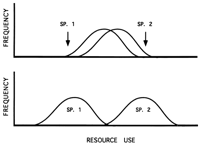 (Upper) Two sympatric species with broadly overlapping distributions of resource use. If resources are limiting, then natural selection may favor individuals in each species with traits that allow each of them to use that portion of the resource spectrum not used by the other species, as indicated by the arrows. (Lower) The result may be that the species diverge in trait value and resource use, thus minimizing competition for resources.
(Upper) Two sympatric species with broadly overlapping distributions of resource use. If resources are limiting, then natural selection may favor individuals in each species with traits that allow each of them to use that portion of the resource spectrum not used by the other species, as indicated by the arrows. (Lower) The result may be that the species diverge in trait value and resource use, thus minimizing competition for resources.In 1956, the American entomologists William L. Brown (1922-1997) and Edward O. Wilson (1929-) compared the characters of a number of species living together--or, in technical terms, living in sympatry--with characters in the same species living apart, or in allopatry. They found that sympatric species possessed many different characters although these same species were sometimes indistinguishable when living allopatrically. Brown and Wilson concluded that these situations resulted from competition: because the species were similar, they competed for the same resources and natural selection favored those species that competed less. Thus, the characters diverged.
Character Displacement
Ecological character displacement and the study of adaptation